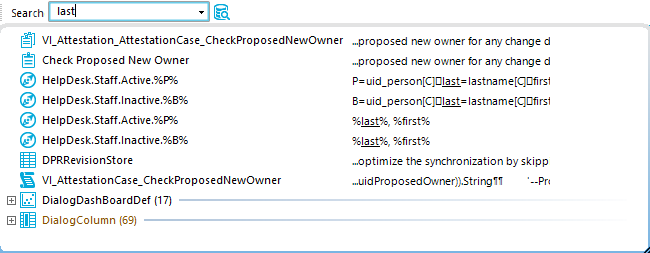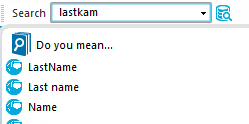Use full-text search to look for entries within the internal Designer database. You will find the full text search on its own menu bar in the Designer.
To search for a term
-
Enter your search term in the Search field.
You can enter more than one partial terms. You can use * as a wildcard. Case sensitivity is not taken into account. Entries are searched for that contain all the partial terms given.
The objects found are entered in a list as you enter the search term.
Figure 26: Displaying the source

-
The icon to the left of the entry shows the entry’s object type (table),e.g. a process, a table or a menu item.
-
The source that the object is extracted from is shown to the right of the entry. The search term is highlighted by an underline.
-
Database tables, object relations and the exact source are also displayed in a tooltip.
-
Double-click an entry to switch to the corresponding object.
If no entries are found for a search term, the system makes suggestions that you can use as search terms by double-clicking.
Figure 27: Suggestions for search terms

If you have selected an entry, the search term is added to the search history and is therefore available for further searches.
-
Open the search history with the arrow in the search field.
-
When you select an entry, all available sources are shown.
The number of entries in the search history depends on your program settings.
Figure 28: Search history

TIP: Update the full text catalog of the Designer database if you need to include objects in the search that have been edited after the program started, like new processes or column names. You do this with Update index, in the search history.
It is possible to limit the number of list entries in certain the Designer editors by using a filter. After creating a filter, the filter conditions are immediately implemented on the set of result currently displayed. A filter remains in use until you reset it.
The main components of a user filter are:
You have the option to set up ad-hoc filters and permanent filters. Ad hoc filters are used for a one-off reduction of list entries. These filters are not saved and are applied to the data immediately.
Create a permanent filter if you want to reuse certain search queries on a frequent basis. Permanent filters are saved in the user configuration and therefore are always available for use.
Detailed information about this topic
Ad hoc filters are used for a one-off reduction of list entries. These filters are not saved and are applied to the data immediately. The WHERE clause wizard helps you formulate a condition for database queries. The complete database query is composed internally.
To use an ad-hoc filter in the Designer
-
In the Designer, select the Filter > Define filter menu item.
-
In the Where Clause Wizard, create the filter condition.
IMPORTANT: Enter the condition for limiting the result set in SQLite notation. The condition is defined as a valid where clause for database queries. The condition relates to the selected database table found that is determined when the editor starts.
Related topics
The system searches for the search term in the display values of the selected object definition, using the wildcards.
To create a filter query using placeholders in the Designer
-
In the Designer, select the Filter > Manage filters menu.
-
Click New filter.
-
In the Define a filter dialog, select the Wildcard filter method.
-
In the Filter parameter pane, enter the following information.
-
Filter objects of: The object definition for the list is already selected.
-
Search pattern: Enter the search pattern. You can use * as a wildcard in the search pattern.
Examples:
Pattern* - searches for all entries whose display value starts with the Pattern string
*Pattern - searches for all entries whose display value ends with the Pattern string
*Pattern* - searches for all entries whose display value contains the Pattern string
Pattern - searches for all entries whose display value matches the Pattern string
-
To save the filter, enter a name and a description for the search filter in the Save filter pane and click Save.
-
(Optional) To make the filer available to all users
-
Click Publish.
-
Confirm the security prompt with Yes.
-
(Optional) To apply the filter immediately, click Filter.
-
Select the Database > Save to database and click Save.
Related topics



